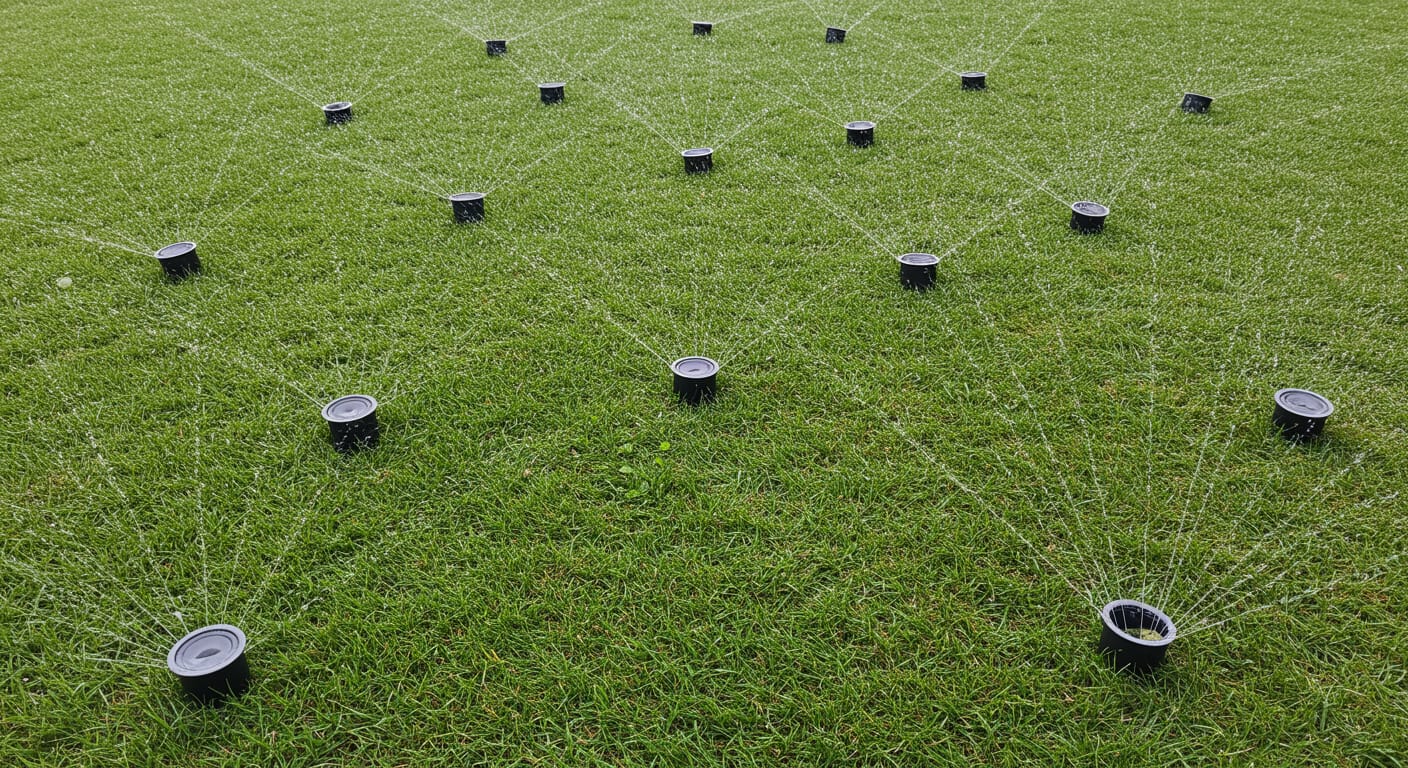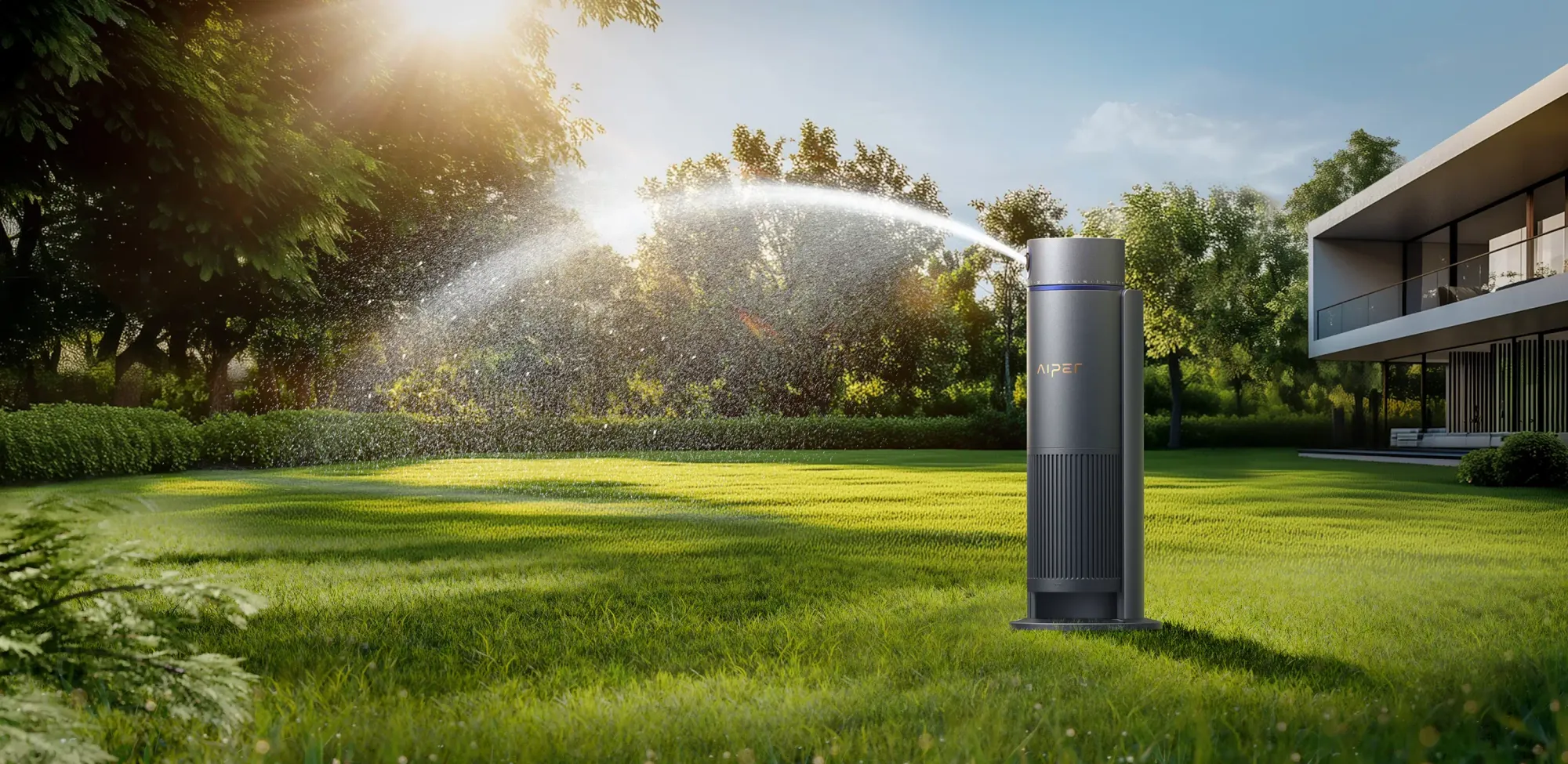How Much Does It Cost to Water Your Lawn (And How to Cut Your Water Bill in Half)

You grab your latest summer water bill, glance at the total, and your jaw drops — it’s twice what you paid last month. Maybe even three times. You think, “There’s no way I used that much water.” But when you walk outside, you spot the real culprit quietly whirring away: your lawn sprinklers.
Why Is My Water Bill So High? Understanding Your Lawn’s Thirst
According to the U.S. Environmental Protection Agency (EPA), outdoor water use can account for 30% to 60% of a household’s total water consumption, and in hotter, drier regions, that number climbs even higher. What’s more surprising is that most homeowners have no idea how much water their irrigation systems are actually using.
The truth is, many people are watering their lawns completely blind. They set the sprinkler timer and assume it’s doing just enough to keep the grass green, without realizing that every extra minute of run time could be adding hundreds, even thousands, of gallons (and dollars) to their monthly bill.
That’s where this guide comes in. In the next sections, you’ll learn how to calculate lawn irrigation costs step by step, from understanding how much water your lawn really needs to measuring what your sprinklers are actually using. This knowledge is the foundation for saving money on watering your lawn and keeping those summer bills in check.
So, let’s start at the root of the problem by learning the simple math behind your lawn’s true water needs.
The Core Formula: How Much Water Does Your Lawn Actually Need?
Before measuring your sprinkler’s output, you must establish a baseline for what your lawn needs to stay healthy. Once you know that, you can compare it with what you’re actually using and find the gap (read: wasted water and wasted money).
The Basic Water-Needs Formula
Here’s the foundational formula for calculating the target water volume:
Lawn Area (sq. ft.) × Desired Depth (inches) × 0.623 = Total Gallons Needed
The number 0.623 is the conversion factor: it’s the number of gallons required to cover one square foot of soil with one inch of water.
Let’s say your lawn is 5,000 sq ft and you aim for 1 inch of water per week.
5,000 × 1 × 0.623 = 3,115 gallons.
It is important to note that this formula calculates what the soil must absorb, not what the sprinkler must output. That distinction is key because your system is likely outputting more than the soil accepts (due to overspray, wind, evaporation, inefficiencies), and that’s where the extra cost comes in.
3 Ways to Measure Your Actual Sprinkler Usage
Now that you know how much water your lawn should need, the next step is figuring out how much water your sprinkler system is actually using. The difference between those two numbers is where most of the waste—and high costs—hide. To uncover that gap, you’ll need to measure your real-world usage. Below are three practical methods that range from precise to quick estimates, so you can find the one that best fits your needs.

Method 1: The Water Meter Audit (The Gold Standard)
If accuracy is your top priority, this is the most dependable method for determining exactly how much your irrigation system costs to run.
Here’s how to do it:
Shut off all other water sources. Make sure no one is using water in or around the house—turn off faucets, dishwashers, washing machines, and ice makers.
- Locate your water meter. It’s typically housed near the curb or sidewalk in a covered box.
- On digital meters, you’ll see a row of numbers—these represent gallons or cubic feet used.
- On analog meters, look for dials or wheels that record usage as they spin.
- Take a starting reading. Record the exact number displayed before turning on your sprinklers.
- Run one irrigation zone. Set it to operate for its usual cycle—typically around 15–20 minutes.
- Take an ending reading. Once the cycle finishes, check the meter again and note the new number.
- Do the math: (Ending Reading – Starting Reading) = Gallons Used for that Zone.
- Repeat for all zones. Test each sprinkler zone separately, then add them together to calculate your total system usage.
This method leaves little room for error and gives you an accurate picture of how much water—and money—you’re really pouring into your lawn.
Method 2: The “Catch Can” Test (The Gardener’s Way)
If you prefer a hands-on, low-tech approach, the Catch Can Test is an easy and effective way to measure your sprinkler’s performance. It not only tells you how much water your system puts out but also whether it’s distributing water evenly across your yard.
Follow these steps:
- Gather containers. Collect 5–10 identical, flat-bottomed items such as tuna cans, shallow bowls, or rain gauges.
- Place them around one zone. Scatter them randomly but evenly throughout the test area.
- Run the system. Turn on that irrigation zone for exactly 15 minutes.
- Measure the results. Use a ruler to record how much water (in inches) has collected in each container.
- Calculate the precipitation rate: (Average depth in inches) × 4 = Inches of water per hour.
If all containers have roughly the same water level, your system has good coverage. But if some are nearly dry while others overflow, that’s a red flag: your sprinklers may be misaligned, clogged, or unevenly spaced. Those inconsistencies are often the silent culprits behind overwatering, patchy grass, and higher water bills.
Method 3: The System Estimation Method (The “Good Enough” Way)
If you can’t access your water meter or don’t have time for a full test, this shortcut gives you a reasonable estimate of your lawn’s water use.
The goal here is to find out the Gallons Per Minute (GPM) that each sprinkler head produces.
Here’s how:
- Find your sprinkler model number. Check the top or side of the sprinkler head—common brands include Rain Bird, Hunter, or Orbit.
- Look up manufacturer data. Visit the manufacturer’s website or product manual to find the GPM chart. These charts show wateroutput based on nozzle size and household water pressure (usually measured in PSI).
- Add up the numbers. For each zone, sum the GPM of all sprinkler heads.
- Use this formula: Total Gallons = Σ (GPM of all heads in Zone × Run Time of Zone).
While not as exact as a meter audit, this “good enough” estimate is useful for getting a quick sense of your irrigation costs without leaving your desk or getting your hands dirty.
Each of these methods has its strengths, but all share one goal: to make your water use visible. Once you know what your sprinklers are actually using, you can start cutting waste and keeping your lawn (and your budget) healthier.
How to Calculate the True Cost
Knowing how many gallons your sprinklers use is a great start but it’s only half the story. The real cost hides in the fine print of your water bill, buried behind units, tiers, and seasonal adjustments that make your actual price per gallon anything but straightforward. This section will help you decode your bill so you can find out exactly what that water is costing you.
Decoding Your Utility Bill
Start by grabbing your latest water bill and locating the water rate section. You’ll usually see charges listed as either:
Per 1,000 gallons, or Per CCF (short for Centum Cubic Feet).
If your utility uses CCF, remember this key conversion:
1 CCF = 748 gallons.
You’ll need this number to convert your irrigation usage into the same units your water company bills you for. Once you’ve done that, you can multiply your total gallons used (from your meter or test) by the rate on your bill to find your true cost per watering cycle.
The “Hidden Costs” That Inflate Your Bill
Even after you’ve done the math, your water cost may be higher than expected because what you see on the bill isn’t always what you pay.
- Tiered Water Rates: Most utilities charge more as your usage increases. The first few thousand gallons might be billed at $5 per 1,000 gallons (Tier 1), but once you exceed that, rates can jump to $12 or more per 1,000 gallons (Tier 3). Irrigation water nearly always lands in those higher-priced tiers, making it your most expensive water of the month.
- Sewer Fees: Many water districts base sewer charges on total water consumption. Unfortunately, this means you’re often paying to “treat” water that never enters the sewer—it just evaporates off your lawn. This can easily add 20–40% to your bill during irrigation season.
- Seasonal Rates: Some cities switch to higher rates during summer months or apply surcharges when demand peaks. Even if you water the same amount, you’ll pay more simply because it’s July instead of March.
What the EPA WaterSense Program Recommends
To truly take control of your irrigation costs, it helps to follow advice from the experts. The EPA’s WaterSense program—the nation’s leading authority on water efficiency—has published clear best practices that can help you maintain a healthy lawn while dramatically cutting water waste.
The “Cycle and Soak” Best Practice
According to the EPA WaterSense program, one of the most effective watering strategies is the Cycle and Soak method, especially for clay soils or sloped yards.
Instead of running sprinklers for 30 straight minutes (which usually leads to runoff), water in short bursts: Water for 10 minutes. Wait about an hour for absorption,then water another 10 minutes.
This allows the soil to fully absorb water between cycles, helping it reach the deep roots where it’s needed most rather than running off into the sidewalk or gutter.
The Benchmark for Inefficiency
According to the EPA, the average irrigation system operates at only 50–60% efficiency, largely due to leaks, wind drift, and poor design.
In real terms, that means to deliver one inch of water to your soil, you might actually have to spray 1.5 to 2 inches. The rest literally blows away or evaporates, wasting thousands of gallons and inflating your bill for water your lawn never received.
Now that you understand where inefficiency hides, let’s look at how to fix it.
7 Proven Strategies to Reduce Your Irrigation Costs
Now that you know how to measure your system and decode your bill, it’s time to take action. These proven strategies are grouped by cost and effort—starting with free fixes, moving to simple weekend projects, and ending with smart investments that offer the biggest return.
Water at the Right Time
Run your sprinklers between 4–8 AM. During these hours, the wind is calm, temperatures are lower, and evaporation is minimal. Watering early also avoids overnight moisture, which can cause fungal lawn diseases.
Mow Higher
Raise your mower blade to 3 inches or more. Taller grass shades the soil, slows evaporation, and encourages deeper root growth—helping your lawn stay green longer with less water.
Conduct a DIY Audit
Use the Catch Can Test described earlier to check for uneven watering. Adjust sprinkler heads that spray sidewalks or driveways and reposition any that overlap or miss key areas.
Check for Leaks
Manually run each irrigation zone and walk your yard. Look for puddles, bubbling water, or broken nozzles—these small leaks can waste hundreds of gallons per week.
Upgrade to a Smart Controller
Traditional timers don’t think, they just run. A smart irrigation controller works like a thermostat for your lawn, automatically adjusting watering schedules based on weather, soil moisture, and temperature.
According to the EPA, WaterSense-labeled controllers can save over 7,000 gallons per year for a typical home.

For instance, a next-generation irrigation system could use Wi-Fi connectivity to link directly with local weather stations. It would automatically skip watering on rainy days and adjust schedules on cooler days, reducing water waste without compromising your lawn’s health. Such smart automation could save 20–40% on water bills annually.
Convert to Drip Irrigation
For flowerbeds, shrubs, or trees, drip irrigation is over 90% efficient. It delivers water directly to the root zone with minimal evaporation, perfect for reducing waste.
Install a Rain Sensor
This small, inexpensive device connects to your existing controller and prevents watering during or right after rain. It’s one of the simplest upgrades with the quickest payback.
A Real-World Example: Calculating Costs in Phoenix, Arizona
Let’s put all this theory into perspective with a real-world example based on 2025 residential water rates in Phoenix, Arizona. Phoenix is known for its hot, arid climate, which makes lawn irrigation both essential and expensive if not managed carefully.
The Local Calculation
As of March 2025, the water rate for city residents in Phoenix, Arizona, is structured in three parts: a fixed monthly service charge (which includes a set water allowance), volume charges for usage exceeding that allowance (which vary by season), and environmental charges applied to all usage.
Low Season (December-March) Correct Rate Example (Inside City):
- Fixed Charge: $4.64 (for 5/8" meter), which includes a 5-unit allowance (3,740 gallons).
- Volume + Environmental Charge (for usage above 5 units): $5.55 per unit (748 gallons).
Using your example of a 5,000 sq. ft. lawn that needs 3,115 gallons of water per week (approximately 18.05 units per month), here’s the math for the Low Season:
- Total Monthly Units: 18.05 units
- Units Over Allowance: 18.05 - 5.00 = 13.05 units
- Cost of Excess Usage: 13.05 units × 5.55/unit = $72.43
- Fixed Monthly Service Charge: $4.64
- Total Estimated Monthly Water Cost: $72.43 + $4.64 = $77.07
Therefore, running your sprinklers three times a week during the Low Season would add up to roughly $77.07 per month (solely for water charges, excluding sewer fees and taxes).
Common Questions About Lawn Watering Costs (FAQ)
Here are concise answers to the most common questions homeowners have about sprinkler usage and cost.
Q: How long should I run my sprinklers to get 1 inch of water?
A: That entirely depends on your system’s precipitation rate. Use the “Catch Can Test.” If you measure 0.5 inches in 15 minutes, your rate is 2 inches per hour, so you’d need to run the system 30 minutes to get 1 inch.
Q: How much money can a smart controller really save me?
A: Most users report savings of 20-40 %. For example, if your monthly irrigation bill is $200 during peak season, a smart controller could save you $40-$80 per month.
Q: Is it cheaper to water at night?
A: No. While evaporation is lower at night, the water sits on grass blades all night, which encourages fungal diseases. The best time (most efficient and safe) is pre-dawn or early morning (4 AM-8 AM).
Take Control of Your Water Bill for Good
Calculating your irrigation cost is a two-part process. Measure your actual gallon usage (with a meter, catch cans, or estimate). Then, understand the true cost on your bill (including tiered rates, sewer fees, and seasonal surcharges).
Once you know your baseline usage and cost, you’re empowered to track the impact of simple changes (mowing higher, timing correctly) and smart investments like smart controllers and drip systems. You’ll begin to see real savings, not just vague hopes.
Book your professional irrigation audit now and start saving water and money. Or explore our smart irrigation tools and control your water bill, your way.
Reference Sources
- US EPA, O. (2017, January 16). Watering Tips. www.epa.gov. https://www.epa.gov/watersense/watering-tips
- Catch Can Test for Water Efficiency | Cocoa, FL - Official Website. (2025). Cocoafl.gov. https://www.cocoafl.gov/1771/Catch-Can-Test-for-Water-Efficiency
- Water and Sewer Rates. (2023). Phoenix.gov. https://www.phoenix.gov/administration/departments/waterservices/city-services-bill/water-sewer-rates.html

